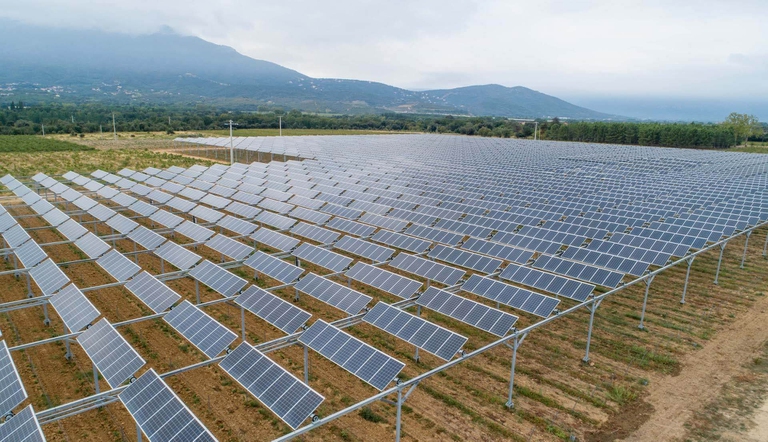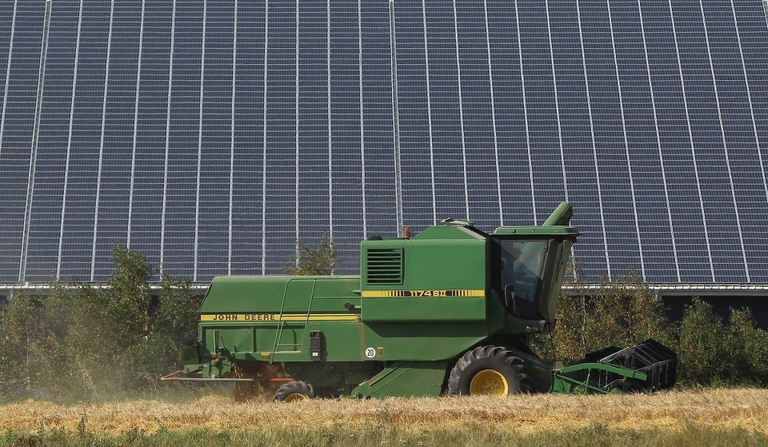https://www.lifegate.it/agrivoltaico-vantaggi-svantaggi
- |
The term agrivoltaic means the union between agriculture and photovoltaics, an innovative and according to many experts promising way to make the most of the earth's resources and solar energy at the same time.This practice involves the integration of photovoltaic systems within agricultural areas, thus allowing a double use of the available space and environmental benefits.
In short, agrivoltaics is an approach that combines the solar energy production through photovoltaic panels with cultivation or sheep farming on the same land.This synergy allows us to maximize land use, reduce environmental impact (even if not everyone agrees on this point, as we will see shortly) and optimize water resources.

Advantages and disadvantages of agrivoltaics
Advantages of agrivoltaics
Those who support the diffusion and development of agrivoltaic systems refer to various and undoubted advantages, such as:
- Space maximization:the integration of photovoltaic systems within agricultural areas allows the land to be exploited efficiently, allowing the production of both food and energy;
- Diversification of income sources:farmers can benefit from an additional source of income deriving from solar energy production, reducing economic dependence on agricultural crops alone;
- Reduction of environmental impact:the combined use of land for agriculture and solar energy production contributes to the reduction of greenhouse gas emissions due to the production of electricity that would otherwise be produced elsewhere and with other less sustainable sources.
Finally, the systematic approach, centered on agronomic bases, would thus be able to increase crop yields:while it is true that vegetables need sun to grow, not all crops need a lot of light.Indeed, some of these may need more shade, such as salad.Shading crops means less water evaporates in an open, sunny field.In this sense, agrivoltaics promotes better management of water resources.
Disadvantages of agrivoltaics
The main disadvantage, highlighted by various categories of environmental activists, lies in the possible conflicts over land use:in fact, the integration of photovoltaic systems within agricultural areas can generate controversies regarding the competition for land use, especially in regions where land availability is limited.The risk is that the priority agricultural use of the land would disappear.
The same movements that oppose the construction of agrivoltaic systems point out that it's not about waging war on renewable sources but how necessary is legislation capable of carefully evaluating project by project, territory by territory, thus avoiding standard guidelines that put the speculative aspect first and leave out issues related to the landscape.Also of this opinion are those who maintain that renewables, in particular photovoltaic panels, should be installed first on the already anthropized areas, such as roofs of houses or warehouses, roads and car parks, rather than occupying agricultural fields.

What incentives with the Pnrr?
The National Recovery and Resilience Plan (Pnrr) is actively promoting the adoption of agrivoltaics in Italy.Gilberto Pichetto Fratin, Minister of the Environment and Energy Security, presented a proposal for a decree with the aim of installing at least 1.04 GW of agrivoltaic systems by 30 June 2026.This regulatory initiative, aimed at "promoting coexistence between agricultural excellence and solutions for the production of clean energy", was subjected to evaluation by the European Commission.
The resources allocated for this initiative, as outlined in the Pnrr, amount to almost 1.1 billion euros.The ministry predicts “that especially innovative projects will be favored, with a predominantly vertical structure and the use of high-efficiency modules”.The incentives provided include a capital contribution of up to 40 percent of eligible costs and an incentive tariff for electricity produced and fed into the grid.The Energy Services Manager (GSE) will be responsible for managing this measure and access to the incentive mechanism.
Specifically, two distinct power contingents are foreseen:one of 300 MW intended only for the agricultural sector for power plants up to 1 MW.And a second one is also open to temporary business associations made up of at least one entity from the agricultural sector for systems of any power.
Fundamental element of the measure, to guarantee the implementation of projects that generate competing agriculture/energy benefits and evaluate their effects over time it is the monitoring system.It is expected, the ministry explains, that these installations guarantee the continuity of theagricultural and pastoral activity underlying the plant for the entire useful life of the systems and that the microclimate, water saving, recovery of soil fertility, resilience to climate change and agricultural productivity for the different types of crops are monitored.
Conclusions and future developments
In conclusion, agrivoltaics represents an innovative solution to address the challenges related to energy production and sustainable agriculture.While there are some disadvantages and challenges to address, many argue that the environmental, economic and social benefits are promising, prompting the idea that this practice could play a significant role in the future of sustainable energy and food production.
Also, from January 24th has entered into force the decree on renewable energy communities (Cer), which the Ministry of the Environment and Energy Security published precisely to stimulate the birth and development of energy communities and self-consumption throughout Italy.THE'integration between energy communities and agrivoltaics will strengthen the integrated and collaborative approach to energy production and distribution, involving agricultural companies among the producing entities.
The combination of these two initiatives can contribute to create more resilient, autonomous and aware communities from an energy point of view.As he explained the engineer Giuseppe Milano, general secretary of Greenaccord and author of Energy communities.Social and environmental generativity experiments (Pacini editore, 2024), “if the energy communities born from the bottom have a strong social vocation, elevating themselves to an instrument of inclusion, even the Ceres born through agrivoltaics could pursue the same trajectory, as there are already numerous experiences of disadvantaged or fragile people who work in the fields who could be remunerated for their work not only by the sale of agricultural products, but also with incentives or possible energy trading carried out by the new legal entities".
